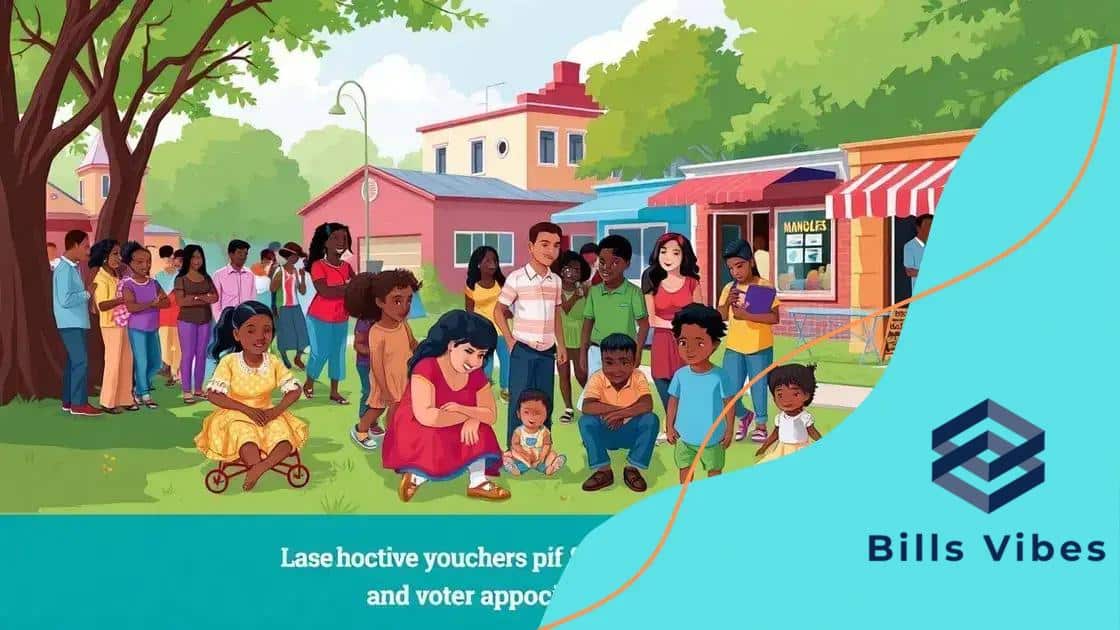Housing vouchers expansion: your guide to benefits

Housing vouchers expansion increases access to affordable housing, providing financial support to low-income families while enhancing community integration and driving economic growth.
Housing vouchers expansion is a significant step toward making housing accessible for more families. Have you ever wondered how these vouchers could change lives and communities? Let’s explore the ins and outs of this important topic.
Understanding housing vouchers
Understanding housing vouchers is essential for grasping how they can assist families in need. Housing vouchers are designed to make housing affordable for those who may struggle to pay rent. They serve as a bridge, connecting low-income families to better living conditions without overwhelming financial strain.
What are housing vouchers?
Housing vouchers are government-funded programs that provide financial assistance to help individuals pay for their housing. They are commonly known as Section 8 vouchers in the United States. With this support, families can rent homes in the private market, promoting choice and flexibility in housing options. The vouchers pay a portion of the rent directly to landlords, while the tenants cover the remainder.
Types of housing vouchers
There are various types of housing vouchers, including:
- Tenant-based vouchers: These vouchers allow the recipient to choose their housing unit where the landlord agrees to rent it.
- Project-based vouchers: These are tied to specific housing projects and are typically available for people living within those complexes.
- Homeless assistance vouchers: Targeted at individuals experiencing homelessness, providing them with immediate shelter and supportive services.
Understanding these types of vouchers helps families identify which program suits their needs best. With housing vouchers, selectivity is key; it’s not just about affordability but also about finding the right home in a supportive community.
Moreover, the use of housing vouchers has wider implications for neighborhoods. By allowing low-income families to move into diverse areas, these programs can stimulate local economies and foster inclusivity. However, challenges remain, and it’s crucial to navigate those to harness the full potential of these programs.
Importance of housing stability
Stable housing contributes significantly to a family’s well-being. When families have a consistent place to live, they can focus on education, health, and employment. Vouchers play a role in ensuring that families are not uprooted frequently due to financial constraints. By promoting stability, communities can thrive and individuals can achieve their goals more effectively.
In summary, understanding housing vouchers not only enlightens families on available assistance options but also highlights their significance in promoting social equity and community development. By engaging with these programs, families can work toward a more secure and fulfilling future.
How housing vouchers can benefit families
How housing vouchers can benefit families is a crucial aspect of understanding housing assistance. These vouchers can ease financial pressure, allowing families to focus on their overall well-being instead of struggling with rent. This financial support plays a vital role in creating stability and opportunities for growth.
Financial relief
One of the most significant benefits of housing vouchers is the financial relief they provide. Families utilizing these vouchers typically pay only 30% of their income towards housing expenses, while the government covers the rest. This reduction in housing costs allows families to allocate their resources toward necessities like education, healthcare, and food.
- Improved quality of life: Families can afford safer and more suitable living environments.
- Increased savings: With lower rents, families might save more for emergencies or future needs.
- Better educational opportunities: Families can move to neighborhoods with better schools.
These advantages significantly contribute to a family’s overall quality of life. Living in a stable, secure environment can empower families to thrive and aim for better futures. Furthermore, the flexibility provided by housing vouchers enables families to choose their homes in various neighborhoods, enhancing their living situation.
Community integration
Housing vouchers also foster community integration. When families move into diverse neighborhoods, they can connect with various community resources and services. These connections improve their access to support networks, enhancing their lives.
Examples of resources available in integrated communities include:
- Healthcare services: Access to nearby clinics and hospitals.
- Job opportunities: Proximity to businesses and employment centers.
- Social services: Community programs helping with education and skill-building.
Integrating into diverse communities may lead to enriched social interactions and shared experiences that benefit families. The support from community members can help families build their networks, contributing positively to their well-being.
Ultimately, housing vouchers empower families to lift themselves and create a foundation for future success. From financial relief to increased community connections, these programs have the potential to positively impact the lives of countless individuals.
The impact of housing vouchers expansion on communities

The impact of housing vouchers expansion on communities is a vital topic that showcases how these programs can reshape neighborhoods and lives. Expanding housing vouchers increases access to quality housing, which can lead to more stable and diverse communities.
Economic Growth in Communities
When more families receive housing vouchers, they can move into areas with better job opportunities and services. This influx of residents helps boost local economies as families spend money in their neighborhoods. Local businesses benefit from increased foot traffic and sales.
- Job creation: New residents stimulate demand for jobs in retail, services, and construction.
- Increased property values: Vibrant neighborhoods attract further investment and improve property values.
- Support for local schools: More families can lead to better funding for local schools through increased enrollment.
The positive ripple effects extend beyond just economics. Families feeling secure in their housing are more likely to engage with their community and contribute positively.
Social Stability and Integration
Housing vouchers also promote social stability. When families can afford to live in safer and more resource-rich areas, their overall well-being improves. Access to education, healthcare, and recreational activities becomes easier, creating a more integrated society.
As communities diversify through the expansion of housing vouchers, cultural exchange and understanding thrive. This integration can lead to:
- Greater tolerance: Interaction among diverse groups promotes acceptance and reduces prejudice.
- Shared resources: Communities can pool resources to create support networks benefiting everyone.
- Improved civic engagement: Residents taking pride in their community are more likely to participate in local governance and events.
Additionally, stability provided by affordable housing can lead to improved health outcomes for families. With stable living situations, families can focus on health and wellness rather than juggling financial stress.
Ultimately, the expansion of housing vouchers has the potential to revitalize communities. It provides economic and social benefits, making neighborhoods more attractive and cohesive. Embracing this expansion can lead to thriving communities where families can flourish together.
Challenges faced in housing voucher programs
Challenges faced in housing voucher programs are significant and can impact the effectiveness of these essential services. While housing vouchers aim to provide support for low-income families, there are obstacles that hinder their success and delivery.
Limited Availability
One major challenge is the limited availability of housing vouchers. Many families that apply for assistance often find that there are not enough vouchers to meet demand. This scarcity can leave many eligible families without the support they need.
- Long waiting lists: Families may wait months or even years for a voucher.
- Funding constraints: Government budgets often restrict the number of vouchers issued.
- Geographic discrepancies: Some areas have more available vouchers than others, creating inequities.
This situation creates frustration and can lead to increased homelessness among vulnerable populations.
Stigma and Misunderstanding
Another significant challenge is the stigma associated with housing vouchers. Often, landlords may be hesitant to accept tenants who use vouchers due to preconceived notions. Such stigma can limit housing options for families actively seeking homes.
Many renters experience:
- Discrimination: Some landlords may outright refuse to rent to families using vouchers.
- Limited choices: Families can find themselves in less desirable neighborhoods.
- Reliance on referrals: Families depend on referrals from housing authorities to secure suitable housing.
These issues create barriers that prevent families from accessing stable housing, further complicating their living situations.
Administrative Challenges
Administrative hurdles also present ongoing challenges within housing voucher programs. Inefficiencies in processing applications and managing funds can lead to delays and frustration for families.
Common administrative issues include:
- Processing delays: Lengthy application reviews push back the time families receive assistance.
- Complex requirements: Many families struggle to complete paperwork due to its complexity.
- Lack of staff training: Insufficiently trained personnel may not provide the support families need.
These barriers not only create obstacles in the distribution of housing vouchers but can also diminish the overall effectiveness of the programs.
Addressing these challenges is essential for making housing voucher programs more accessible and effective in supporting families in need.
Future trends in housing assistance
Future trends in housing assistance suggest a shift toward more inclusive and effective programs aimed at supporting families in need. As society evolves, so too does the approach to housing assistance, addressing contemporary challenges and embracing technology.
Increased Use of Technology
One of the exciting trends is the increasing use of technology in housing assistance programs. Digital tools can streamline processes, making it easier for families to apply for and manage their housing vouchers. This shift not only reduces paperwork but also enhances communication between applicants and housing authorities.
- Online applications: Families can submit their applications easily from home.
- Real-time updates: Applicants receive immediate information about the status of their applications.
- Mobile apps: Users can manage their benefits and communicate with agencies via smartphone applications.
The implementation of these technologies can make housing assistance more accessible and user-friendly, thereby reaching a wider audience.
Focus on Holistic Support
Future housing assistance programs are likely to emphasize holistic support. Instead of only providing financial aid, these programs are evolving to offer additional resources that address families’ overall needs.
This holistic approach may include:
- Job training programs: Helping families acquire skills necessary for employment.
- Financial education: Teaching families how to budget and manage their finances responsibly.
- Health services: Connecting families to healthcare providers for physical and mental health support.
Such comprehensive support can empower families, helping them not just survive but thrive in their communities.
Enhanced Collaboration with Local Governments
In the future, we may see stronger collaborations between housing assistance programs and local governments. These partnerships can maximize resources and create a more united front against housing insecurity.
Through collaborative efforts, cities can:
- Identify housing needs: Conduct assessments to understand community requirements more effectively.
- Coordinate resources: Pool funds and services to address local housing challenges.
- Implement inclusive policies: Develop laws that support affordable housing development and maintenance.
By working together, local governments and housing agencies can create sustainable solutions to housing issues, improving conditions for everyone.
The trends in housing assistance point to a future where communities are more empathetic and proactive in addressing the challenges faced by families. Enhanced technology, a focus on holistic support, and collaboration can lead to transformative changes in how housing is accessed and maintained.
In conclusion, the expansion of housing vouchers represents a significant step toward addressing housing instability and improving the lives of families in need. By overcoming challenges such as limited availability and stigma, these programs can provide essential support to many. Looking ahead, trends like increased use of technology, holistic support systems, and enhanced collaboration with local governments will shape the future of housing assistance. Together, we can build a stronger, more inclusive community where everyone has access to safe and affordable housing.
\n\n
\n
FAQ – Frequently Asked Questions about Housing Vouchers and Assistance
What are housing vouchers?
Housing vouchers are government-funded programs that help low-income families pay for housing by providing financial assistance.
How can housing vouchers benefit families?
Housing vouchers can provide financial relief, improved living conditions, and access to better educational and healthcare resources.
What challenges do families face when using housing vouchers?
Families may encounter limited availability of vouchers, stigma from landlords, and administrative hurdles that complicate the process.
What are future trends in housing assistance?
Future trends include increased use of technology, holistic support services, and enhanced collaboration between local governments and housing agencies.






